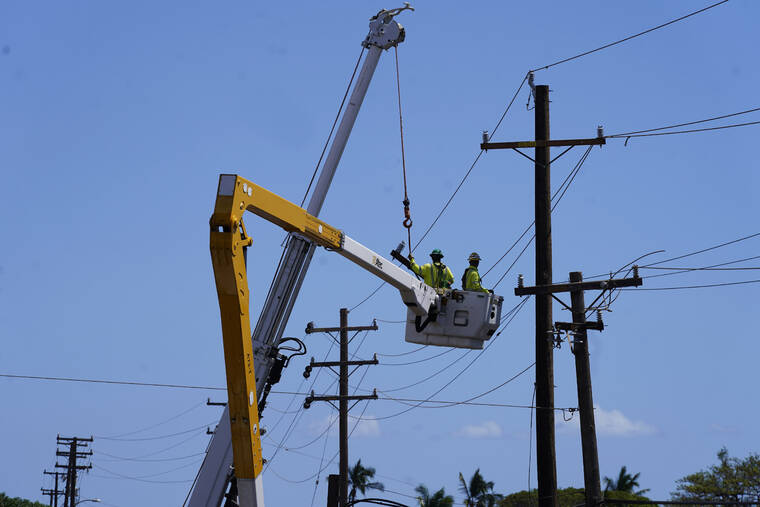Hawaiian Electric shares drop another 31% as liability concerns mount

RICK BOWMER / ASSOCIATED PRESS
Linemen work on poles Sunday in Lahaina. Hawaiian Electric Co. faces criticism for not shutting off the power amid high wind warnings and keeping it on even as dozens of poles began to topple. Several lawsuits have already been fired and the company’s stock has plummeted.
Hawaiian Electric Industries, which supplies roughly 95% of the state’s residents with power, traces its roots back to 1891, just a decade after King Kalakaua met Thomas Edison to see the incandescent light bulb. Now, the utility is facing what’s shaping up to be the biggest-ever test over its future.
Relentless selling on Monday wiped more than a $1 billion from the company’s value as the stock plunged by a third in its biggest loss on record. Shares extended the freefall today, shedding 31% after Hawaiian Electric was cut to junk by S&P Global Ratings.
At the close of trading on Wall Street, Hawaiian Electric shares had fallen $6.67 to $14.79, a 52-week low.
Investors are dumping holdings amid increasing scrutiny over power equipment as the possible source of the deadly Maui wildfires.
Analysts are starting to raise questions over whether Hawaiian Electric, one of the smallest publicly traded U.S. utilities, will be able to withstand the pressure if it does end up being at fault.
To be clear, no official cause of the wildfire, which has become the deadliest in the U.S. in more than a century, has been identified. And it could be weeks — even months — before any investigation is finalized.
Don't miss out on what's happening!
Stay in touch with breaking news, as it happens, conveniently in your email inbox. It's FREE!
Still, lawsuits have already been filed against Hawaiian Electric amid reports of downed power lines that were knocked over by strong winds in the lead up to the blazes.
Damages from the tragedy have so far reached more than $5.5 billion, according to federal estimates, an amount that dwarfs Hawaiian Electric’s market capitalization of about $2.4 billion as of Monday’s close.
“Given the size of the company, I don’t know how they would be able to account for this if they are found negligent or imprudent,” said Shahriar Pourreza, a utility analyst for Guggenheim Securities. “It’s hard to see the company emerging from this tragedy in its current form.”
Honolulu-based Hawaiian Electric, which operates the Maui Electric utility, declined to comment on its stock price drop and the potential for legal liability. The utility said it’s focused on restoration efforts, damage assessment and local community support.
Read more: Attorneys aim to make Hawaiian Electric pay for Maui disaster Opens in a new tab
“At this early stage, the causes haven’t been determined,” the company said in a statement. “We will work closely with state and county as they conduct their review.”
Lawsuits on behalf of victims were filed that allege the company’s Maui utility was negligently responsible for the wildfire that leveled Lahaina, destroying more than 2,000 homes and structures.
If the utility is held liable in a worst-case scenario, it may be forced to restructure in a bankruptcy, or it could be taken over in a government bailout, Pourreza said. In the near term, Hawaiian Electric could face a liquidity crunch with banks hesitating to loan the company money needed to fund its operations given the potential liability risk, he said.
“If you are a lender to the company, I think you’re going to take a step back and say: I’m going to wait to see how things play out,” he said.
On Monday, Guggenheim cut its price target for Hawaiian Electric from $32 apiece to $18, warning it could go lower. The shares closed down 34% at $21.46 the same day.
The company has come under criticism for not turning off power despite warnings of critical fire conditions due to predicted dry, gale-force winds. The utility has said that preemptive short-term shutoffs have to be coordinated with first responders, and in Lahaina, electricity powers the pumps that provide the water needed for firefighting.
There’s precedent for large wildfire liabilities pushing a utility into a crisis and bankruptcy.
PG&E Corp., California’s largest utility, was forced to reorganize in 2019 after its wind-damaged equipment sparked some of the most destructive wildfires in state history resulting in estimated claims of more than $30 billion.
The company was threatened with a state takeover, but ultimately reached a Chapter 11 settlement with California that resulted in closer regulatory oversight of its operations and the payment of billions of dollars of claims to fire victims.
If there is a link to power lines, Hawaiian Electric will have to be shown to be negligent or that it could have reasonably prevented a loss, a higher legal standard than the one applied to utilities in California, according to analysts.
“If there was negligence, I would expect all options, including bankruptcy for Maui Electric, to be on the table,” said Jay Rhame, chief executive officer of utility investor Reaves Asset Management. Reaves doesn’t hold shares of Hawaiian Electric in its portfolio, Rhame said.
The company’s insurance coverage is likely under $1 billion, Wells Fargo utility analyst Jonathan Reeder said in a note Monday. It’s unclear if the parent company could “ring-fence” potential liabilities within its Maui Electric subsidiary, according to the note.
Meanwhile, traditional utility investors will likely stay away from the company’s stock, said Andy Bischof, a utility analyst for Morningstar.
“This is something that is going to play out for some time,” Bischof said. “For a utility investor, it’s probably not a risk profile they would be willing to accept.”




